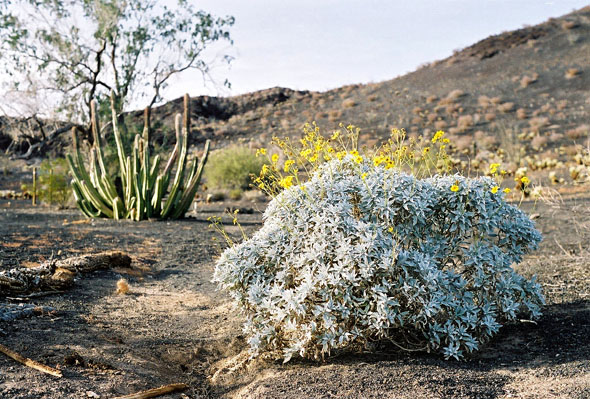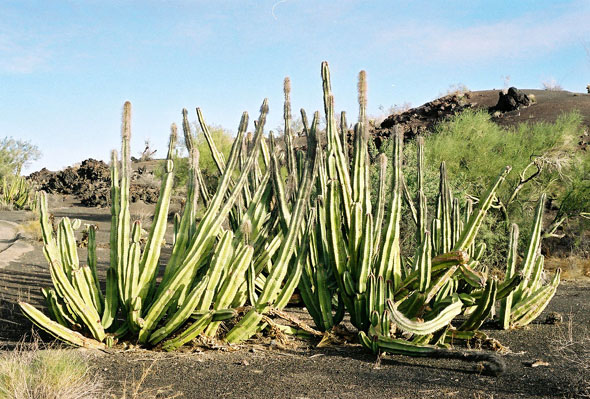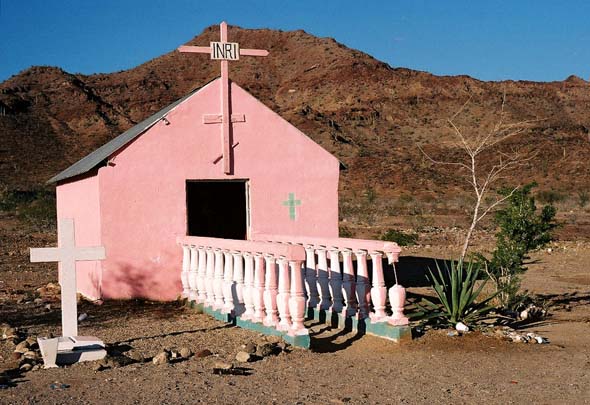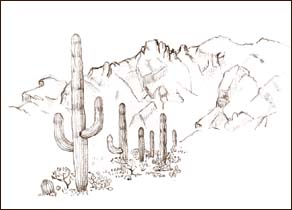| Winter in the Sonoran Desert | |
 | |
|
Tecolate Reserva de la Biosfera El Pinacate y Gran Desierto de Altar Sonora, Mexico (December, 2001)
Just south of the border and Organ Pipe National Monument is Reserva de la Biosfera El Pinacate y Gran Desierto de Altar, a 2000-km volcanic region containing more than 10 giant craters and 400 cinder cones. Author William K. Hartmann describes this area as the "black heart of the Sonoran Desert."
This new national park is virtually undeveloped, with one-lane sand and cinder roads and no facilities whatsoever.
We spent a night under an impossibly starry night alone in the saddle between two cinder cones at Tecolate, 22 miles from the park entrance. Henceforth our strong morning camping coffee with canned milk shall be known as "teco latté." | |
 | |
|
Senita Cactus Reserva de la Biosfera El Pinacate y Gran Desierto de Altar Sonora, Mexico (December, 2001)
The Spanish name for this cactus is cabeza de viejo (old man's head). Though it is has roughly the same shape as the organ pipe cactus, the senita's stems are covered with long, bristly gray spines.
Rare throughout Arizona and Sonora, the senita is perversely abundant in the baked and blackened cinder soil of El Pinacate.
| |
 | |
|
A Sense of Place Roadside Shrine South of Sonoyta Sonora, Mexico (January, 2002)
The rugged lava flows, drifting sand dunes and absence of natural water supplies in the Pinacate country blocked travelers who tried to open Mexico's northern frontier.
"Because the Pinacate country formed an obstacle to civilization's advance, it became a last, hidden fastness of the pristine Sonoran Desert -- reason enough to celebrate this peculiar landscape. As more and more people flock to the Sonoran Desert Sunbelt, they seem to know less and less about it. More accurately, the sense of place declines, because new citizens come too fast, and try to convert the desert to Cleveland before they can learn about the presence and pace of this alien land."
-- William K. Hartmann, Desert Heart: Chronicles of the Sonoran Desert
|

|
View of the Santa Catalina Foothills from Downtown Tucson (January, 2002)
Keith's drawing shows the Santa Catalinas from central Tucson, before the foothills were developed.
Despite their apparent hardiness, saguaro cacti are very fussy about where they'll grow. They're partial to the sun-drenched south-facing bajada slopes. Unfortunately, those same slopes are also most coveted by developers.
|
|
Congress Hotel Tucson (January, 2002)
I prefer the visual cacaphony of central Tucson to the carefully orchestrated monotony of the suburbs. The mosaic of crumbling stucco, exposed adobe brick and rampant red bougainvilla pleases my eye. The fruit of the overgrown prickly pears are manna to an extraordinary population of desert birds.
Our neighborhood near Stone and Grant is too poor to bear the newly chic label of "barrio," but it is rich in artistic expression. The unfinished wall murals, gnarly metal sculptures and smatterings of ceramic tile are sometimes appealing, sometimes disturbing -- but always vigorous, original and authentic. |
|
| Seasons | Spring | Summer | Monsoon | Fall | Winter |
 |
 |
 |
 |
 |
 |
